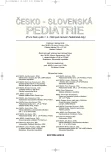Delayed Puberty Onset and Short Stature as First Signs of Swyer’s Syndrome?
Authors:
L. Šabová 1; Z. Blusková 1; D. Virgová 2; V. Cingel 3; J. Porubský 4; Ľ. Košťálová 1
Authors‘ workplace:
II. detská klinika LFUK a DFNsP, Bratislava
prednosta prof. MUDr. L. Kovács, DrSc., MPH
1; Pediatricko-neonatologické oddelenie NsP Levice, n. o.
primárka MUDr. D. Virgová
2; Klinika detskej chirurgie LFUK a DFNsP, Bratislava
prednosta doc. MUDr. J. Trnka, CSc.
3; Ústav patologickej anatómie LFUK, Bratislava
prednosta prof. MUDr. Ľ. Danihel, PhD.
4
Published in:
Čes-slov Pediat 2010; 65 (3): 110-116.
Category:
Case Report
Overview
A 15-year-old patient sent to the pediatric endocrinologist for short stature and lack of spontaneous puberty development. Her phenotype including external genitals was female. Ultrasonography and MRI of the pelvis detected a hypoplastic uterus, but the presence of ovaries was not clearly described. Laboratory tests showed high levels of both gonadotropins LH and FSH, and low level of estradiol and testosterone. The karyotype revealed a 46,XY chromosomal constitution. Laparoscopy proved small uterus with Fallopian tubes bilaterally. Histological investigation did not confirm the structure of ovaries nor testes.
The diagnosis of pure gonadal dysgenesis (Swyer’s syndrome), which belongs to the disorders of sexual differentiation, was assessed. Our patient is treated with small doses of estrogens to induce puberty and being child born small for gestational age (SGA) she is treated also with growth hormone for short stature.
Key words:
Swyer’s syndrome, pure gonadal dysgenesis, short stature, delayed puberty onset
Sources
1. Hughes IA, Houk C, Ahmed SF, Lee PA. Lawson Wilkins Pediatric Endocrine Society/European Society for Paediatric Endocrinology Consensus Group. Consensus statement on management of intersex disorders. J. Pediatr. Urol. 2006; 2(3): 148–162.
2. Lisá L. Poruchy gonád na genetickém podkladě. In: Lisá L, Seemanová E, Zuntová A. Poruchy funkce gonád. Praha: Triton, 2004: 11–93.
3. Behtash N, Karimi Zarchi M. Dysgerminoma in three patients with Swyer syndrome. Wld J. Surg. Oncol. 2007; 5: 71.
4. Marchina E, Gambera A, Spinelli E, et al. Identification of a new mutation in the SRY gene in a 46,XY woman with Swyer syndrome. Fertil. Steril. 2008; 91(3): 932.
5. Seemanová E. Poruchy gonadálního a pohlavního vývoje – gonadální dysgeneze v důsledku genetické mutace. In: Lisá L, Seemanová E, Zuntová A. Poruchy funkce gonád. Praha: Triton, 2004: 95–120.
6. Pleskačová J, Šnajderová M, Lebl J. Disorders of sex differentiation: genes responsible for development of genital system and final phenotype. Čes. Gynekol. 2009; 74(3): 192–197.
7. Gemelli G, Gemelli S, Dimasi N, et al. Identification and molecular modeling of a novel familial mutation in the SRY gene implicated in the pure gonadal dysgenesis. Eur. J. Hum. Genet. 2007; 15(1): 76–80.
8. Stoicanescu D, Belengeanu V, Amzar D, et al. Complete gonadal dysgenesis with XY chromosomal constitution. Acta Endocrinol. 2006; 2(4): 465–470.
9. Tagliarini EB, Assupcao JG, Scolfaro MR, et al. Mutations in SRY and WT1 genes required for gonadal develepment are not responsible for XY partial gonadal dysgenesis. Braz. J. Med. Biol. Res. 2005; 38(1): 17–25.
10. Feit JP, David M, de Peretti E, Chopard A, Forest M, Jeune M. XY pure gonadal dysgenesis. Two cases report. Arch. Fr. Pediatr. 1980; 37(2): 111–112.
11. Tsutsumi O, Iida T, Taketani Y, Sugase M, Nakahori Y, Nakagome Y. Intact sex determining region Y (SRY) in a patient with XY pure gonadal dysgenesis and a twin brother. Endocr. J. 1994; 41(3): 281–285.
12. Sills IN, Rapaport R, Skuza KA, Horlick MN. 46,XX pure gonadal dysgenesis with growth hormone deficiency and impaired 3 beta-hydroxysteroid dehydrogenase activity. Am. J. Med. Genet. 1992; 42(1): 100–103.
13. Lisá L. Disorders of sexual differentiation and sexual development. Čes.-slov. Pediat. 1992; 47(11): 673–677.
14. Cools M, Drop SLS, Wolffenbuttel KP, et al. Germ cell tumors in the intersex gonad: Old paths, new directions, moving frontiers. Endocr. Rev. 2006; 27(5): 468–484.
15. Kříž J. Poruchy sexuální diferenciace. Urol. List. 2007; 5(1): 12–15.
16. Zielinska D, Zajaczek S, Rzepka-Górska I. Tumors of dysgenetic gonads in Swyer syndrome. J. Pediatr. Surg. 2007; 42(10): 1721–1724.
17. Hermus R, de Leeuw BH, Wolffenbuttel KP, et al. New insights into type II germ cell tumor pathogenesis based on studies of patients with various forms of disorders of sex development (DSD). Mol. Cell Endocrinol. 2008; 291(1–2): 1–10.
18. Mazanec K, Vorechovský I. Histopathology of gonads in syndromes of abnormal sexual differentiation. Čes. Patol. 1989; 25(1): 54–60.
19. Michala L, Goswami D, Creighton SM, et al. Swyer syndrome: presentation and outcomes. BJOG 2008; 115(6): 737–741.
Labels
Neonatology Paediatrics General practitioner for children and adolescentsArticle was published in
Czech-Slovak Pediatrics

2010 Issue 3
- What Effect Can Be Expected from Limosilactobacillus reuteri in Mucositis and Peri-Implantitis?
- The Importance of Limosilactobacillus reuteri in Administration to Diabetics with Gingivitis
Most read in this issue
- Lactose Intolerance
- Acute Injury in Children – Therapy and Prognosis
- Delayed Puberty Onset and Short Stature as First Signs of Swyer’s Syndrome?
- Natal and Neonatal Teeth
